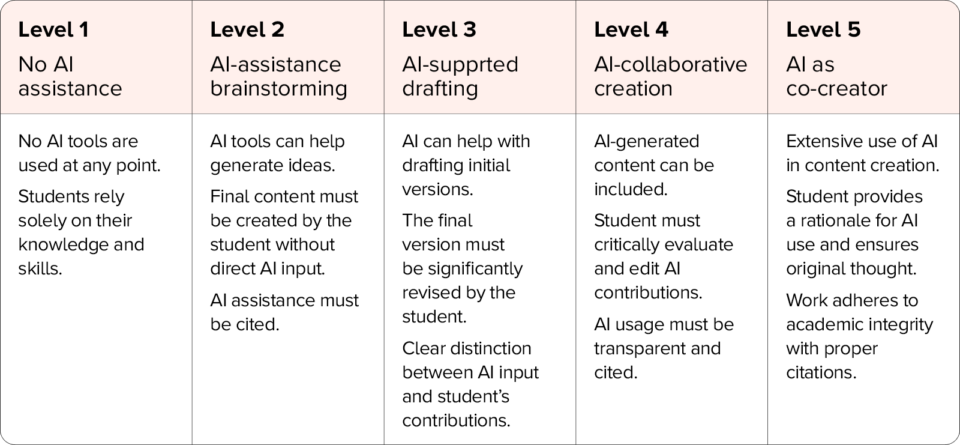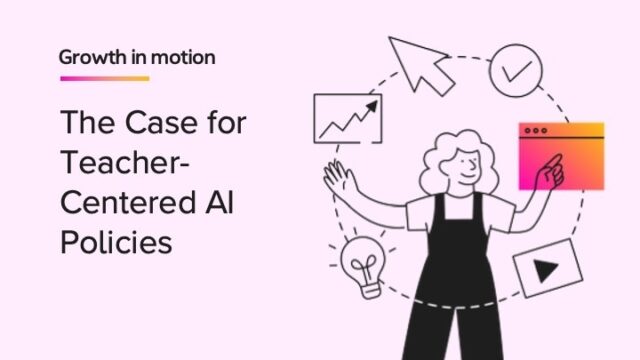
A few weeks ago, I was scrolling through social media and came across an adorable video of a few bunnies bouncing lightly on a trampoline. Without a thought, I quickly shared it with a couple of friends. A few days later, my feed was filled with videos of people lamenting the fact that the latest viral AI-generated video had tricked them. You guessed it; it was the bunnies on the trampoline. As a fairly critical media consumer, animal videos aside, I was a little embarrassed to have fallen prey to the most recent viral AI slop. Still, it served as a nice low-stakes reminder of the need for more critical evaluation of resources on our AI-fueled internet.
We have likely all observed the rise of GenAI in our lives—from AI summaries in search results to AI chatbots like ChatGPT in our pockets. It is nearly ubiquitous at this point, both for ourselves and our students. Artificial intelligence has been used in the education setting for many years in the form of adaptive learning software and tutoring tools, but the launch of GenAI chatbots has reinvigorated interest in the integration of AI in the classroom setting. The ease of use, relatively democratized access, and increasingly powerful models employed by chatbots have led to wider interest and adoption in the K–12 education setting.
A recent Gallup poll from the 2024–2025 academic year reported that nearly 60% of teachers reported incorporating AI tools into their regular teaching activities. Teachers report utilizing AI for a variety of different tasks, including streamlining classroom organization and management, supporting differentiation, facilitating feedback and assessment, enhancing instructional creativity, and planning lessons, with some users reporting time savings of nearly six hours per week.
Similarly, the HMH Educator Confidence Report, an annual survey of over 1200 educators from across the United States, found a significant uptick in AI usage with nearly six times more educators reporting using AI in the classroom in the last two years. Perhaps most significantly, nearly 4 out of 5 educators report feelings of confidence in using the tools in the classroom in an “instructionally effective” way.
An annual survey of over 1200 educators from across the United States, found a significant uptick in AI usage with nearly six times more educators reporting using AI in the classroom in the last two years.
The rapid increase in availability of new tools and resources does not appear to be slowing down. If recent investments in AI training are any indication, things are just beginning to pick up speed. It’s a great time to begin exploring the field to see how these tools might support you in the classroom. As with any innovation, it can be difficult to know where to begin, so we’ve assembled a few recommendations based on research from early adopters to ease you into the GenAI landscape.
1. Cultivate AI literacy
One of the easiest ways to get started with GenAI in the classroom is by developing a working understanding of GenAI tools, their affordances, and their limitations. For many, AI can still feel a bit magical, so learning more about what’s happening under the hood can help to demystify the technology and support the development of a more realistic set of expectations surrounding its use.
This understanding of how, when, and why to utilize AI, along with a deeper understanding of the ethical and social implications of its use, is known as AI literacy. According to a recent systematic review of the literature, AI literacy is defined as “a set of competencies that enables individuals to critically evaluate AI technologies; communicate and collaborate effectively with AI; and use AI as a tool online, at home, and in the workplace.” AI literacy is a critical component of any plan for integration. GenAI is tremendously powerful, but there are still blind spots: shallow explanations, factual inaccuracies, quality concerns, and biases are just a few. Not only are users with higher levels of AI literacy more equipped to effectively leverage these tools, but they are also more equipped to critically evaluate the increasing presence of AI-generated content in their daily lives.
Several organizations have emerged to offer guidance and recommendations to support the development of AI literacy for both teachers and students. AI4K12, ISTE, and Digital Promise both offer resources, frameworks, and training materials to help teachers begin their journey toward AI literacy. Developing your own AI literacy is an excellent way to ease into integration.
2. Simplify classroom management
Once you’ve developed some background knowledge about how GenAI works and some of the potential pitfalls, you’re ready to start experimenting. Critically reflective experimentation can help you to integrate these tools more thoughtfully over time.
As you get started, it can be helpful to learn more about what other teachers are doing in their classrooms. The research suggests that most teachers begin their AI journey by utilizing the tools to simplify classroom management, organization, and lesson planning.
A recent report by the RAND Foundation highlights how K–12 teachers are using AI tools in the classroom. The primary applications include:
- Modifying instructional resources for accessibility
- Changing the language or adjusting the readability of a resource
- Offering differentiated or modified question sets
- Adding support like sentence stems
- Simplifying or modifying instructions
- Assessing student learning
- Generating new or additional questions to gauge understanding
- Offering alternative response modalities
- Changing the structure of existing test banks
- Creating differentiated versions of existing assessments
The tools offer tremendous potential, but they still require a thoughtful educator with a critical eye to unlock that potential and leverage the tools for maximum effect in the classroom. More and more states are issuing human-centered policy guidance designed to acknowledge the power of the human in partnership with technology, not the power of the technology alone.
3. Encourage student use of AI
While the research indicates that teachers’ uptake of AI tools has increased, many teachers still express reluctance and concern about student use of GenAI in the classroom. For many teachers, this may be the next step in the journey toward classroom implementation.
Much of the existing state-level guidance provides high-level principles to district leaders on approaching AI tools rather than offer concrete strategies for supporting their thoughtful and effective use. One example that offers a stark contrast is the Washington Office of Superintendent of Public Instruction, which includes a helpful scaffolding tool to support teachers as they consider opening the door to student usage.

Notice again that the guidance is highly scaffolded and human-centered, meaning that the focus is on the student and how AI can be used to support their existing work, not supplant it. Students are encouraged to use GenAI as an assistant and a cocreator rather than as a tool to generate answers and products. AI tools are just that—tools, and they are only as effective as the person wielding them.
AI is here to stay
It is difficult to find an area of our lives that remains untouched by AI. While it is clear that AI is here to stay and will dramatically shape our lives moving forward, one thing remains unchanged: the importance of the human in the process. As teachers, we have a unique opportunity to help shape the narrative around AI in our students’ lives and ensure that they are uniquely prepared to both identify its presence in their world and use it in ways that support cognition, not replace it.
***
HMH AI Tools are designed to teach with you, not for you. Get support in every moment of the teaching cycle, from lesson planning and prep to post-instruction communication.
HMH AI Tools are designed to teach with you, not for you.














